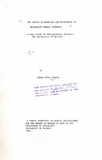| dc.description.abstract | This study is an analysis of the impact of Marriage and Motherhood .
on female students in the University of Nairobi. Its main purpose was
to establish the difficulties involved in combining university education
with marital and motherhood role obligations and thereby recommend ways
of assisting such students.
The sample for this study consisted of undergraduate female
students. These undergraduate students were in three broad categories,
namely; married mothers, married females with no children and single
mothers. The number of respondents interviewed was one hundred and
thirty.
The sample was selected using the stratified sampling luethod as
well as the snow-ball method of sampling. Non-probability principles of
sampling were employed.
The main method of data collection was interview schedule. A
standardized interview-administered questionnaire was used. It had both
open-ended and closed questions. The researcher carried out the
interviews singly. Other methods of data collection used included simple
observation, panel discussion, key informants and secondary sources.
Motherhood role obligations were found to be very taxing. These
role obligations interfered with the students' health, class attendance,
ability to sit for examinations and use of 'boom'- university slang for
money given by the university to students to assist them meet their
academic requirements such as purchase of books, laboratory equipment,
medical kits etc.
The process of motherhood, (pregnancy and subsequent delivery) was
found to affect the respondents' ability to sit for examinations. The
respondents who were in their late months of pregnancy or who delivered
during the examination terms, (Second or Third Academic Terms) sat for
special examinations. Pregnancy and subsequent delivery also affected
the respondents' health negatively. The expectant respondents had to
attend health clinics and in the process many failed to attend lectures.
Th e single mothers were affected emotionally and socially by the
stigma of having a child out of marriage. Most of their pregnancies
were un-planned and the men responsible did not help them in any way.
After giving birth over 90%
of the single mothers left their
children in the rural areas being taken care of by their relatives while
they resided in the students' halls of residence.
The state of motherhood (being a mother), was also found to be very
taxing to the respondents. The single mothers more than the married
mothers were affected by the financial difficulties associated with
taking care of their children since they had no spouses to'give them
financial assistance. This resulted in the majority of single mothers
using their 'boom' for non-academic purposes. They remitted their
'boom' back home to assist in caring for their children.
Married mothers were fortunate, to have spouses who helped them meet
their financial obligations. However, more married mothers than single
mothers missed attending classes. This was partly due to the fact that
more married mothers than single mothers were non-residents. This meant
that they played a more direct role in taking care of their children
than the single mothers (who were mainly residents). Being non-
residents resulted in the mothers missing many lectures as they were
affected directly by the children's daily needs, problems with maids and
in-laws, transport difficulties and other domestic difficulties.
Despite the stres8 associated with motherhood role obligations,
65 mothers did not use family planning methods , The main reason given for not using family Planning netnods was due to the fears
they held ooncerning contraceptives •
According to the 'study findings, being married but having no children, did not, seem to have a significant irrpact on the students'
life. Trer'e \laS no significant change in health arrong the respondents married but with no children. Marriage did oot seem to affect their use of "boom", their class attendance or their academic performance in any significant way. Motherhood,however, was found to have a negative
impact on the results' academic and non-academic lives.
Too examination performance arrong all three category of respondents
was very good with less tnan 10% having. sat for supplerrentary examinations or repeated an academic year. This good performance was
attriwted to the ooping techniques the respondents had developed. 'These coping technique included limiting their leisure, utilising their
free hours in academic activities, using their 'boern' wisely so as to
purchase academic items, careful planning on when to attend pre-natal and post-natal clinics so as not to miss classes etc.
The study concluded that combining university education with
marriage and notherhood was Very taxing on the students. It reccxmended that the female students be educated on the need for delaying births until completion of their university education; they be given a thorough education concerning family planning methods and warned against pre¬nari tal sex so as to reduce the incidence of unplanned pregnancies
and/or pre-uarital pregnancies. It also recomrended that the university
authorities look into 'ways of assisting those students who were married
or are mothers by providing them with pre-natal and post-natal facilities
and children' s day-care unit building 'them married quarters and providing the with non-residents a college bus to meet their transport
needs. | en |

